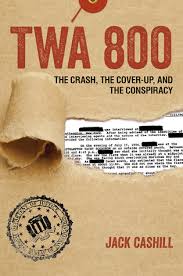How Trump Reversed the Obama Murder Surge
![]()

Order Jack Cashill's latest book, TWA 800: The Crash, the Cover-Up, and the Conspiracy
![]()

About Silenced: Flight 800
and the Subversion
of Justice (DVD) -
-Buy the Silenced DVD-
![]()
© Jack Cashill
June 19, 2019 - WND.com
A December 2018 headline in the New York Times heralded the rare bit of good news the Times allows its readers in the Age of Trump. It read simply, “U.S. Murder Rate for 2018 Is on Track for a Big Drop.”
Although official FBI statistics will not be available until September, the Times acknowledged that “the murder rate in the United States in 2018 is on track for the largest one-year drop in five years.” The preliminary estimate of 7 percent translates into about a thousand fewer deaths.
One word missing from the article by Jeff Asher, not surprisingly, is “Trump.” Another word missing is “Obama.” Asher and his editors prefer that the cause of crime fluctuations remains a mystery.
If there were a Pulitzer for evasion, Asher would be in the running “Tracking the change in murder nationally is far easier than explaining why it’s happening,” he wrote. “There is still no consensus on why murder rose nationally in 2015 and 2016, though various theories have been proposed, including simple randomness.”
Among those who are willing to see what happened in 2015 and in 2016, there is a consensus. Chicago Mayor Rahm Emanuel put his finger on it during an emergency meeting of mayors and police chiefs in late 2015.
If the media chose to remain clueless, Emanuel did not. He explained the phenomenon to Attorney General Loretta Lynch, saying “[Cops] don’t want to be a news story themselves. They don’t want their career ended early, and it’s having an impact.”
As Emanuel knew, the crime surge really began in August 2014. A day after the Ferguson, Missouri, shooting of Michael Brown by Police Officer Darren Wilson, the Washington Post’s Jonathan Capehart appeared on MSNBC to explain what happened. He got everything wrong.
Capehart linked the Brown shooting to that of Trayvon Martin two years prior, accepted the testimony of a bogus “hands up, don’t shoot” witness as gospel, and insisted that black men in America were living “under siege.” For the next six months, this was the message broadcast by all the major media save Fox News.
Three days after the shooting the Washington Post did a Trayvon treatment on Brown, running a large photo of Michael Brown in cap and gown and explaining how this “gentle giant,” the guy “too timid” for football, had persevered to earn a diploma of some sort.
Five days after the shooting, President Obama addressed the nation on the subject of Ferguson. As an African American, he was uniquely positioned to tell the truth.
Obama might have said that Brown, like Trayvon Martin before him, bounced from home to home as his family fell apart, descended into a life of drugs and violence, and projected his rage against his parents on to a white authority figure.
Obama did none of that. He did what he had done in the Trayvon case, identify his fate with the “victim,” in this case Michael Brown. “We lost a young man, Michael Brown, in heartbreaking and tragic circumstances,” said Obama at a press conference. “He was 18 years old, and his family will never hold Michael in their arms again.”
Later, after meeting with Ferguson protestors, Obama imagined himself in Brown’s shoes, “My mind went back to what it was like for me when I was 17, 18, 20.” In a very real sense, he gave his blessing to the mob.
About Officer Wilson, Obama had nothing much to say. As Ferguson burned, Wilson and his family went into hiding, and he emerged only for his grand jury appearances.
Police nationwide got the message. Even if they did everything right in an interaction with a black person, they could face lawsuits, termination, death threats, and criminal charges, knowing full well that politicians would happily sacrifice their futures to the mob.
Crime expert Heather Mac Donald calls this reaction the “Ferguson Effect.” Wrote Mac Donald in 2016, “Arrests, summonses and pedestrian stops were dropping in many cities, where data on such police activity were available. Arrests in St. Louis City and County, for example, fell by a third after the shooting of Michael Brown. Misdemeanor drug arrests fell by two-thirds in Baltimore through November 2015.”
Seven months after the shooting, the Washington Post ran a Jonathan Capehart column headlined, “‘Hands up, don’t shoot’ was built on a lie.” After the release of a DOJ report, Capehart admitted, “Brown never surrendered with his hands up, and Wilson was justified in shooting Brown.”
The mob never got the memo. They continued chanting, “Hands up, don’t shoot” in whatever fresh city activists and the media conspired to make the new Ferguson. And Obama continued to bless them.
The results were catastrophic. In 2015, the murder rate rose almost 11 percent, the most dramatic spike in fifty years. In 2016, murders increased 8.5 percent over 2015. Nearly 3,000 more Americans were murdered in 2016 than in 2014, roughly 1,800 of them black.
In Missouri, the site of the original incident, the numbers were staggering. Spurred by post-Ferguson mayhem, St. Louis had the highest murder rate in the nation in 2014, a position it held through 2017.
Statewide, the murder rate came close to doubling from 2014 to 2017.
In 2017, the national murder rate flattened out. In 2018, it declined. In 2019, it again seems to be declining. Times editors claim to have no idea why this is happening.
The fact that the mob no longer has a cheerleader in the White House--but the cops do--has likely never occurred to them.

